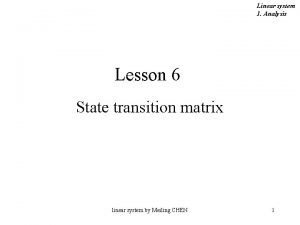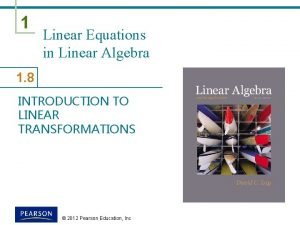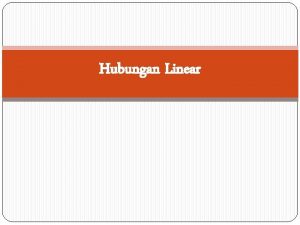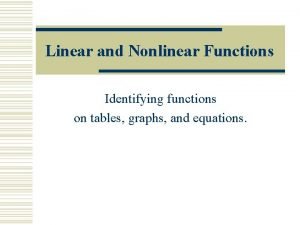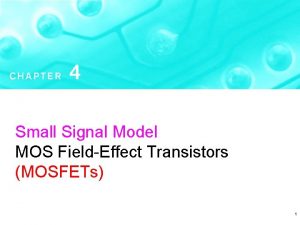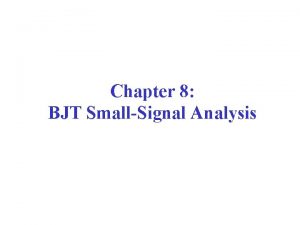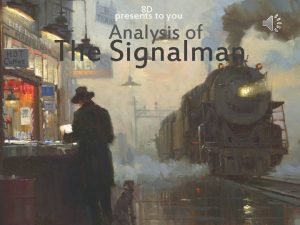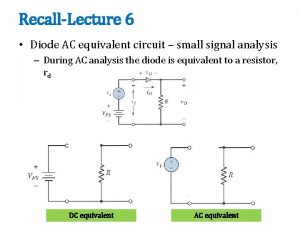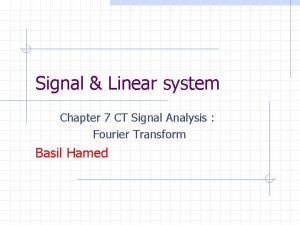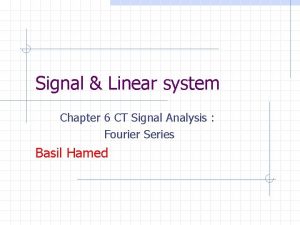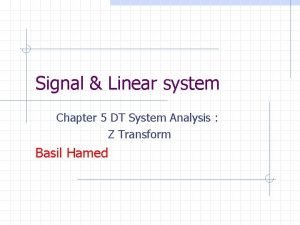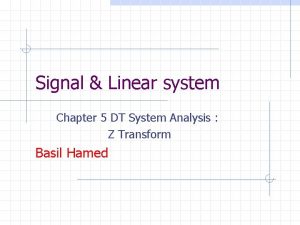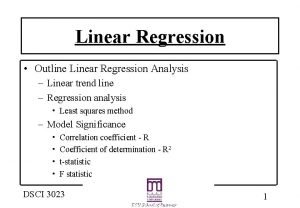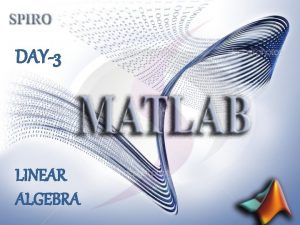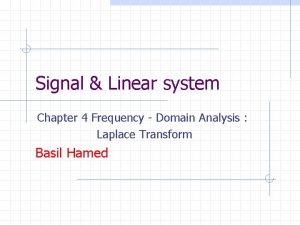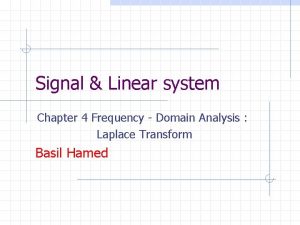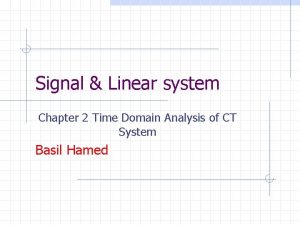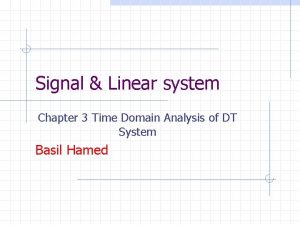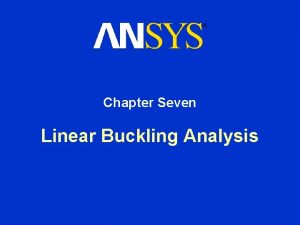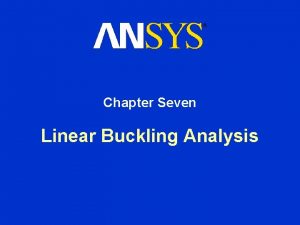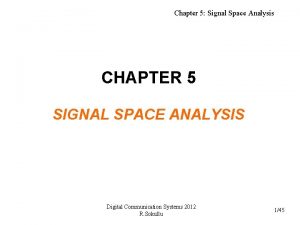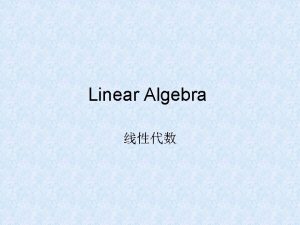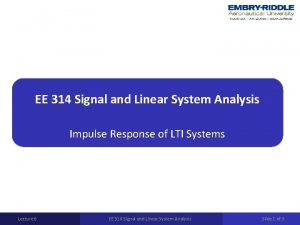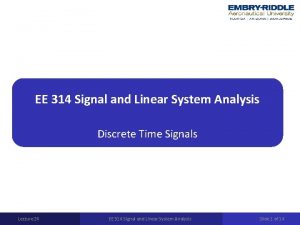Signal Linear system Chapter 6 CT Signal Analysis



































- Slides: 35

Signal & Linear system Chapter 6 CT Signal Analysis : Fourier Series Basil Hamed

Why do We Need Fourier Analysis? n The essence of Fourier analysis is to represent periodic signals in terms of complex exponentials (or trigonometric functions) n Many reasons: n n n Almost any signal can be represented as a series of complex exponentials Response of an LTI system to a complex exponential is also a complex exponential with a scaled magnitude. A compact way of approximating several signals. This opens a lot of applications: n n storing analog signals (such as music) in digital environment over a digital network, transmitting digital equivalent of the signal instead of the original analog signal is easier! Basil Hamed 2

Jean Baptiste Joseph Fourier (21 March 1768 – 16 May 1830) was a French mathematician and physicist born in Auxerre and best known for initiating the investigation of Fourier series and their applications to problems of heat transfer and vibrations. The Fourier transform and Fourier's Law are also named in his honor. Fourier went with Napoleon Bonaparte on his Egyptian expedition in 1798, and was made governor of Lower Egypt and secretary of the Institut d'Égypte Basil Hamed 3

6. 1 Periodic Signal Representation By Trigonometric Fourier Series relates to periodic functions and states that any periodic function can be expressed as the sum of sinusoids(or exponential) Example of periodic signal: A sinusoid is completely defined by its three parameters: -Amplitude A(for EE’s typically in volts or amps or other physical unit) -Frequency ω in radians per second -Phase shift φ in radians T is the period of the sinusoid and is related to the frequency Basil Hamed 4

6. 1 Periodic Signal Representation By Trigonometric Fourier Series “Time-domain” model Given time-domain signal model x(t) “Frequency-domain model” Converting “time-domain” signal model into a “frequency-domain” signal model Basil Hamed 5

6. 1 Periodic Signal Representation By Trigonometric Fourier Series • General representation of a periodic signal • Fourier series coefficients Basil Hamed 6

Existence of the Fourier Series • Existence • Finite number of maxima and minima in one period of f(t) Basil Hamed 7

Dirichlet conditions Condition 1. x(t) is absolutely integrable over one period, i. e. Condition 2. In a finite time interval, x(t) has a finite number of maxima and minima Ex. An example that violates Condition 2. Condition 3. In a finite time interval, x(t) has only a finite number of discontinuities. Ex. An example that violates Condition 3. Basil Hamed 8

How Fourier Series Works Basil Hamed 9

Example 6. 1 P 600 Fundamental period T 0 = p Fundamental frequency f 0 = 1/T 0 = 1/p Hz w 0 = 2 p/T 0 = 2 rad/s Basil Hamed 10

Example 6. 2 P 604 • Fundamental period T 0 = 2 • Fundamental frequency f 0 = 1/T 0 = 1/2 Hz w 0 = 2 p/T 0 = p rad/s Basil Hamed 11

Example 6. 3 P 6. 6 • Fundamental period T 0 = 2 p • Fundamental frequency f 0 = 1/T 0 = 1/2 p Hz w 0 = 2 p/T 0 = 1 rad/s Basil Hamed 12

Example 6. 3 P 6. 6 Basil Hamed 13

The Exponential Fourier Series Basil Hamed 14

The Exponential Fourier Series Basil Hamed 15

The Exponential Fourier Series Basil Hamed 16

The Exponential Fourier Series Basil Hamed 17

The Exponential Fourier Series Basil Hamed 18

Line Spectra: (Amplitude Spectrum & Phase Spectra) Basil Hamed 19

Line Spectra: (Amplitude Spectrum & Phase Spectra) Basil Hamed 20

Line Spectra: (Amplitude Spectrum & Phase Spectra) Basil Hamed 21

Line Spectra: (Amplitude Spectrum & Phase Spectra) Example: Find the exponential Fourier series and sketch the line spectra Solution Basil Hamed 22

Line Spectra: (Amplitude Spectrum & Phase Spectra) Basil Hamed 23

Line Spectra: (Amplitude Spectrum & Phase Spectra) Basil Hamed 24

Line Spectra: (Amplitude Spectrum & Phase Spectra) Basil Hamed 25

Properties of Fourier series Basil Hamed 26

Properties of Fourier series Basil Hamed 27

Properties of Fourier series Basil Hamed 28

Properties of Fourier series Basil Hamed 29

Properties of Fourier series Symmetry Remarks Even Integrate over T/2 only and Odd Multiply by 2 Half-Wave Basil Hamed 30

6. 4 LTI Systems Response To Periodic Input Periodic Basil Hamed 31

6. 4 LTI Systems Response To Periodic Input Basil Hamed 32

6. 4 LTI Systems Response To Periodic Input Basil Hamed 33

6. 4 LTI Systems Response To Periodic Input Basil Hamed 34

Why Use Exponentials The exponential Fourier series is just another way of representing trigonometric Fourier series (or vice versa) The two forms carry identical information, no more, no less. Preferring the exponential forms: - The form is more compact - LTIC response to exponential signal is also simpler than the system response to sinusoids. - Much easier to manipulate mathematically. Basil Hamed 35
 Baseband signal and bandpass signal
Baseband signal and bandpass signal Baseband signal and bandpass signal
Baseband signal and bandpass signal Digital signal as a composite analog signal
Digital signal as a composite analog signal What is the product of an even signal and odd signal?
What is the product of an even signal and odd signal? Linear system analysis
Linear system analysis Linear danger area hand signal
Linear danger area hand signal Simple and multiple linear regression
Simple and multiple linear regression Contoh soal biseksi dan penyelesaiannya
Contoh soal biseksi dan penyelesaiannya Non linear text
Non linear text Non linear plot diagram
Non linear plot diagram Contoh soal metode numerik
Contoh soal metode numerik Which pipeline is linear
Which pipeline is linear Linear and nonlinear
Linear and nonlinear Left-linear grammar
Left-linear grammar Contoh soal fungsi non linear hiperbola
Contoh soal fungsi non linear hiperbola Perbedaan fungsi linier dan nonlinier
Perbedaan fungsi linier dan nonlinier Linearly dependent
Linearly dependent Linear algebra linear transformation
Linear algebra linear transformation Titik penggal adalah
Titik penggal adalah Linear momentum and linear impulse
Linear momentum and linear impulse Persamaan simultan
Persamaan simultan Non linear graph
Non linear graph Linear or nonlinear tables
Linear or nonlinear tables Difference between linear and nonlinear
Difference between linear and nonlinear Nonlinear video editing
Nonlinear video editing Persamaan linear simultan
Persamaan linear simultan Right linear grammar
Right linear grammar Modelos de texto narrativo
Modelos de texto narrativo Tool used in structured design is a
Tool used in structured design is a Which of the following is not a fact finding technique
Which of the following is not a fact finding technique System analysis and design project proposal example
System analysis and design project proposal example Mosfet small signal analysis example
Mosfet small signal analysis example Small signal model bjt
Small signal model bjt Transistor large signal model
Transistor large signal model The signalman class 8
The signalman class 8 Equivalent circuit for zener diode
Equivalent circuit for zener diode




